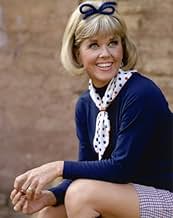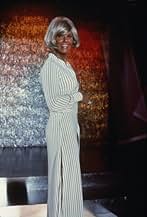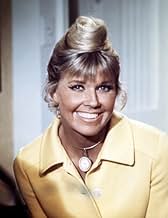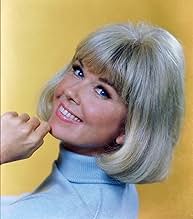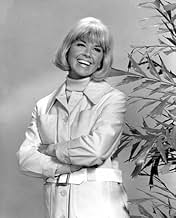Adicionar um enredo no seu idiomaAfter spending most of her life in big cities, widow Doris Martin decides to move back to the family ranch.After spending most of her life in big cities, widow Doris Martin decides to move back to the family ranch.After spending most of her life in big cities, widow Doris Martin decides to move back to the family ranch.
- Prêmios
- 2 indicações no total
Explorar episódios
Avaliações em destaque
I didn't watch much of the Doris Day Show when it was on, I hated the idea that America's top female movie star was forced to do TV. Because I'm a Doris Day collector, I purchased THE DORIS DAY SHOW First Season.
Now, I remember. I saw the first couple of shows and quit watching. Now watching the later shows from the first season, I can't believe how good this is! Leave it to Doris Day to make a silk purse out of a sow's ear. Her acting is incredible -- she doesn't miss a trick. As Jack Lemmon said about Day, "It was elevating to act with her." AND THAT BODY! Doris Day had the best figure in Hollywood. Don't get me wrong, I thought that Marilyn Monroe was voluptuous, but Doris' figure was perfect. She could wear anything and look terrific.
I'm looking forward to the rest of the seasons. On this collection, there are some fun extras, including Doris' two appearances on the TV classic, What's My Line?"
Looking back, Doris Day was robbed. She never got nominated as Best Actress in a comedy by the Emmys. Clearly, she was better than Lucille Ball in the messy and overplayed, "Here's Lucy" and as good or better than the actresses that WERE being nominated during this period. But I must point out, this series was done during the "I hate Doris Day" period in the USA. Everybody frowned on Day as being "too clean" and "a virgin." Of course all of that was nonsense and looks silly today, but that was the atmosphere in which Doris filmed this series.
The Emmys often ignored the best. Remember, the marvelous Esther Rolle was never nominated for her formidable work on "Good Times."
Now, I remember. I saw the first couple of shows and quit watching. Now watching the later shows from the first season, I can't believe how good this is! Leave it to Doris Day to make a silk purse out of a sow's ear. Her acting is incredible -- she doesn't miss a trick. As Jack Lemmon said about Day, "It was elevating to act with her." AND THAT BODY! Doris Day had the best figure in Hollywood. Don't get me wrong, I thought that Marilyn Monroe was voluptuous, but Doris' figure was perfect. She could wear anything and look terrific.
I'm looking forward to the rest of the seasons. On this collection, there are some fun extras, including Doris' two appearances on the TV classic, What's My Line?"
Looking back, Doris Day was robbed. She never got nominated as Best Actress in a comedy by the Emmys. Clearly, she was better than Lucille Ball in the messy and overplayed, "Here's Lucy" and as good or better than the actresses that WERE being nominated during this period. But I must point out, this series was done during the "I hate Doris Day" period in the USA. Everybody frowned on Day as being "too clean" and "a virgin." Of course all of that was nonsense and looks silly today, but that was the atmosphere in which Doris filmed this series.
The Emmys often ignored the best. Remember, the marvelous Esther Rolle was never nominated for her formidable work on "Good Times."
This show ran from 1968 until 1973, and I hadn't seen it on TV probably since its initial run until the DVDs came out. The show aired at a time when American culture was going through a great transition. When Doris Day first went on the air Bonanza and The Andy Griffith Show were the top television draws. By the time it went off the air it was All in the Family and M.A.S.H. Thus it is amazing that Doris Day stayed on the air for five years during this time when her clean-cut image probably set her apart from the crowd, and then walked away from her show - the show was not canceled due to poor ratings. In fact, it did quite well throughout its run.
It will take you back to a simpler time, but then so did Doris Day's films and I still find those enjoyable. The show did make major changes to accommodate the changing times. Initially it had a rural setting with Doris being a widow with two sons who played a major part in the show. First the show had her moving to San Francisco. Next she and her sons moved to a more "hip" apartment. By season four the kids and her widowhood status had disappeared and she was single. Her father and her sons just vanished into thin air, never to be mentioned again.
Also, Doris evolved from a secretary to an associate editor. However, she kept her name and the second apartment she had when her sons had existed. It was very confusing. I'd still recommend it, just remember that culture changed so fast in the U.S. during this time that it even had an effect on how Doris Day was presented.
It will take you back to a simpler time, but then so did Doris Day's films and I still find those enjoyable. The show did make major changes to accommodate the changing times. Initially it had a rural setting with Doris being a widow with two sons who played a major part in the show. First the show had her moving to San Francisco. Next she and her sons moved to a more "hip" apartment. By season four the kids and her widowhood status had disappeared and she was single. Her father and her sons just vanished into thin air, never to be mentioned again.
Also, Doris evolved from a secretary to an associate editor. However, she kept her name and the second apartment she had when her sons had existed. It was very confusing. I'd still recommend it, just remember that culture changed so fast in the U.S. during this time that it even had an effect on how Doris Day was presented.
You all know the backdrop of this series so I won't bore you with it. I love this show and I too like the season 2 and 3 shows the best. As far as format changes go, I think they did a really good job going from season 1 to 2 to 3. It was a logical progression, Doris gets a job, then she moves the family into town etc. I hate the way they changed the format in season 4 and 5. Had I been around at that time to put my two cents in I would have done several things. 1. In season 4 I would have left things exactly as they were in season three and brought in the Peter Lawford character as Doris's serious love interest and possible step father for the boys. This along with the normal goings on would have brought yet another logical advancement. 2. In season 5 I would have Doris and Peter get engaged, Doris gets a new Boss and is promoted to a staff writer position at the magazine. The season finale would have been Doris and Peter's wedding with the entire cast from all the seasons in attendance. This could have been a huge ratings getter and a great way to end the series. I just don't know what they were thinking when they did 4 and 5. There are some episodes that are good but the show is missing the heart it had in 1,2, and 3. As was stated by another poster we cant go back and change history but thankfully there is enough good in seasons 1 2 and 3 that I watch them all the time. A must for Doris Fans.
When I was a kid this was my first exposure to Doris Day. I was only two when this show first aired and I used to watch it every week. However, it was fairly confusing due to the fact that it changed situations almost every season. In the first season she was the typical widowed mom raising her two kids in an almost carbon copy of "Green Acres", but without the surrealism of that show. In the second season we see her become a writer for a magazine, which she would remain, with slight variations for the next few years. However, in the final season, the show pretty much becomes another version of "Mary Tyler Moore" with her now playing a single girl and without the kids that she had for the first few years. However, despite these changes Doris Day retained the charm and grace that made her one of the most popular stars in television.
Also, one thing that is quite ironic is the fact that this show was set in San Francisco, which was the same locale as her former co-star, and close friend, Rock Hudson's series "McMillan and Wife". That fact could have led to all sorts of guest star possibilities.
Also, one thing that is quite ironic is the fact that this show was set in San Francisco, which was the same locale as her former co-star, and close friend, Rock Hudson's series "McMillan and Wife". That fact could have led to all sorts of guest star possibilities.
How this show lasted five years is amazing considering each year the show was about something else. Her trademark theme song said it each week: 'What ever will be will be!' The show aired between 1968 and 1973, a time when women's roles changed in society and on television. "The Doris Day Show" reflected these changes beginning with Doris as a "modern housewife:" a widowed mother of two living in the country, and evolved into a pre-Mary Richards role model for single women in the work place (the first ever on television!) Because each year brought a different look (and different cast) to the show, it is difficult to sell in syndication but perhaps Nick-at-Night which prides itself in the evolution of such shows will have fun with it some day. (My suggestion: Do one of those five nights a week summers where Monday has the first year, Tuesday has the second year, and so forth...each year really was an entity unto itself.) The bottom line is that it features America's sweetheart Doris Day and that's really all that it needed. What ever will be will be.
Você sabia?
- CuriosidadesDoris Day's contract with CBS to do this series set a record, with her production company getting several million dollars in up-front money. It was negotiated by Martin Melcher, her husband of 17 years. However, after Melcher died unexpectedly in April of 1968, just five months before the series was to debut, Day said she had no knowledge of ever having signed on to do the show. It turned out that Melcher and the couple's lawyer and financial advisor had squandered the millions of dollars that Day had made in her 20-year career in films and records, leaving her not only flat broke but also more than $500,000 in debt. Melcher, desperate for money, had used his position as her husband and manager and had contracted with CBS to produce a sitcom for Day, but he never told her about it.
- ConexõesFeatured in Biografias: Doris Day: It's Magic (1998)
Principais escolhas
Faça login para avaliar e ver a lista de recomendações personalizadas
- How many seasons does The Doris Day Show have?Fornecido pela Alexa
Detalhes
- Data de lançamento
- País de origem
- Idioma
- Também conhecido como
- El show de Doris Day
- Locações de filme
- 650 California Street, San Francisco, Califórnia, EUA(Today's World magazine office)
- Empresa de produção
- Consulte mais créditos da empresa na IMDbPro
Contribua para esta página
Sugerir uma alteração ou adicionar conteúdo ausente

Principal brecha
By what name was The Doris Day Show (1968) officially released in India in English?
Responda
